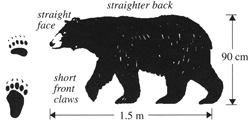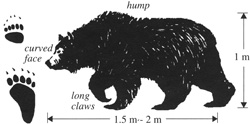What Kind of Bear Is That?
Waterton-Glacier International Peace Park is home to both black and grizzly bears. Even for experts, it is often difficult to distinguish between the species. The following clues will help to tell the species apart:
Color
Color is not a reliable indicator of species. Contrary to their name black bears also come in brown, cinnamon, and blond. Grizzlies range from blond to nearly black. Grizzlies sometimes have silver-tipped guard hairs that give them a "grizzled" appearance.
Physical features
Grizzly bears often have a dished-in face and a large hump of heavy muscle above the shoulders. Their claws are around four inches (10 cm) long. A black bear's facial profile is much straighter from tip of nose to ears, without the dished-in look. Black bears lack the distinctive hump of a grizzly and have shorter claws, generally around one and a half inches (4 cm) long.
Black Bear (Ursus americanus Pallus):
There are black bears in most of Canada's national parks. The smallest of North America's bear species, black bears adapt readily to humans. They tend to hold their heads higher than grizzlies and are agile climbers.

Grizzly Bear (Ursus arctos horribilus Ord)
Grizzly bears are only found in the mountains and the north. The number of grizzlies has declined dramatically; they are now considered a "vulnerable" species in Canada.

Roadside Bears
It's exciting to see bears up close but we must act responsibly to keep them wild and alive. Do not approach bears for pictures or entice them to come closer. Never feed bears! Bears that receive human food may have to be destroyed.
If you see a bear from your car, stay inside. Leaving your vehicle endangers your safety and the bear's, and exposes you, to traffic hazards. If traffic is heavy, keep your eyes on the road and don't stop. Accept the fact that, while your passengers may get a quick look, you may not. If traffic is light, slow down and pull over when it is safe to do so. Don't stop in the middle of the roar, or close to a hill or curve where other drivers may not see you in time to avoid a collision. Exercising some common sense during the excitement of sighting a bear is important to you, the bear, and other visitors.
Hiking In Bear Country
Waterton-Glacier International Peace Park provides a wonderful opportunity to view animals in their natural setting. Along with this opportunity comes a special obligation for the visitor. With just a little planning and forethought, hikers can also help ensure the survival of a protected, threatened species.
Don't Surprise Bears!
Bears will usually move out of the way if they hear people approaching, so make noise. Most bells are not loud enough. Calling out and clapping hands loudly at regular intervals is are better ways to make your presence known. Hiking quietly endangers you, the bear and other hikers.
When bears charge hikers, the trail may be temporarily closed for public safety. While the trail remains closed, other visitors miss the opportunity to enjoy it. A bear constantly surprised by people may become habituated to close human contact and less likely avoid people. This sets up a dangerous situation for both visitors and bears.
Don't Make Assumptions!
You can't predict when and where bears might be encountered along a trail. People often assume they don't have to make noise while hiking on a well-used trail. Some of the more frequently used trails in the park are surrounded by excellent bear habitat. People have been charged and injured by bears fleeing from silent hikers who unwittingly surprise bears along the trail. Even if other hikers haven't seen bears along a trail section recent don't assume there are no bears present.
Don't assume a bear's hearing is any better than your own. Some trail conditions make it hard for bears to see, hear, or smell approaching hikers. Be particularly careful by streams, against the wind, or in dense vegetation. A blind corner or a rise in the trail also requires special attention.
Keep children close by. Hike in groups and avoid hiking early in the morning, late the day, or after dark.
Inform Yourself About Bears
Park staff can help you identify signs of bear activity like tracks, torn-up logs, trampi vegetation, droppings, and overturned rocks. Bears spend a lot of time eating, so avoid hiking in obvious feeding areas like berry patches, cow parsnip thickets, or fields of glacier lilies.
Don't Approach Bears!
Never intentionally get close to a bear. Individual bears have their own personal space requirements which vary depending on their mood. Each will react differently and its behavior can't be predicted. All bears are dangerous and should be respected equally.
***A fed bear is a dead bear! Bears are intelligent and learn very quickly how to obtain human food once they have tasted it. Bears that obtain human food may have to be destroyed. Leaving food, packs, or garbage unattended, even for a few minutes, sets up a potentially dangerous situation.***